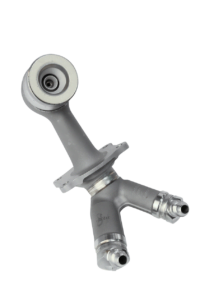
GE’s 3D printed fuel nozzle
“With 3D printing, the old rules of how we design things are out the window,” said Terry Woychowski, VP, NA Test Operations at LINK in his talk on “The Brilliant Machine Age” at the American Automotive Summit. “You can now create a component exactly how you want it, without excess material.” The result is lighter, more cost-effective parts. The opportunities this presents are endless.
We have previously covered additive manufacturing in the automotive industry, but the aerospace industry is another place we are seeing the effects of this new technology today. Despite the tremendous opportunities additive manufacturing presents, it is still a time-consuming process, and therefore best suited for high-end components used in low-volume products, such as aircraft. According to a recent study by ABI Research, due to the sheer size of the American aerospace industry and its defense budget, the U.S. aerospace and defense industries will drive much of the growth in additive manufacturing over the next ten years, producing additive manufactured parts and products with a value of US$17.8 billion in 2026.
GE, one of the world’s biggest manufacturers, has invested $1.5bn in 3D printing. In Auburn, Alabama, they have spent $50million on a factory to print fuel nozzles for the new CFM LEAP jet engine. To date, GE has shipped 25,000 of these fuel nozzles. By 2020, this plant should be printing 35,000 fuel nozzles a year. Each CFM LEAP uses 19 nozzles, which have new features, such as complex cooling ducts, that GE says can be created in no other way. Where this part was previously welded from 20 or more components, it is now just 1 printed piece. Fewer components mean eventual savings on operations and tooling costs and it also means there are fewer parts to break, therefore it is more durable. Perhaps most importantly, the nozzles are 25% lighter than older designs, which will boost the jet engine’s fuel efficiency.
GE currently has 28 machines running full-time at their Auburn facility but, “apart from GE, [most companies] pretty much have 1 or 2 or 3 machines, they’re making some prototype parts but nobody’s really put a full production capability together to really supply a big industry,” says Markus Heinimann, VP, Engineered Product & Process Technology at Arconic to the audience at the American Aerospace & Defense Summit. The ABI Research study finds that 44% of manufacturing companies currently have 3D printers in operation, however, most of these deployments are for prototyping purposes only. Heinimann says that won’t last long, and going forward we will see “exponential growth” with endless possibilities. However, he points out that manufacturers still have a long way to go in figuring out how to best utilize the technology: “Additive Manufacturing is a manufacturing process, just like every other legacy process out there, and to take full advantage of it we have to get to the point where we can design to take advantage of the process and deal with the limitations it has.”
Heinimann talked about how, at Arconic, they are currently using additive manufacturing to expedite the forging process for small-volume jobs: “The problem with forging is while the end product is really good, the numbers of process steps and the number of die sets you need to produce aerospace-grade forgings is significant. That’s a big lead time and it’s a big cost impact. So if I only want 2 or 3 parts I’m not going to go through the whole process. What additive manufacturing allows us to do is it allows us to build our preforms, using either powder or laser wire system, and then I need one forge tool and I heat it once. This means a significant reduction in overhead, CapEx, and lead time. And the final product that I get out of it is a forging, it meets all the forging requirements because it’s gotten a cold work, it’s gotten the compression and everything else that a forging has, and any defects I have were healed.” Going forward, they are experimenting with new alloy compositions to improve the strength of 3D printed parts, and this is a trend that is occurring across the industry.

Join the conversation on new manufacturing technologies at the American Manufacturing Summit! VIEW THE PROGRAM